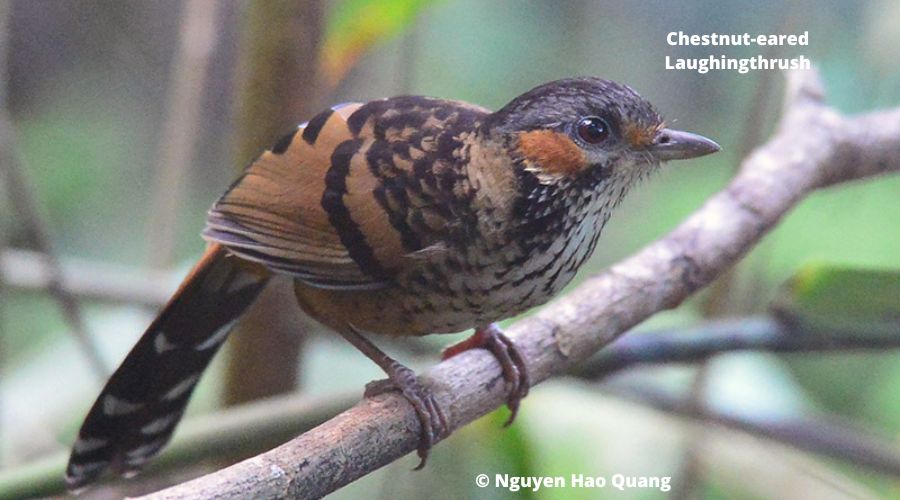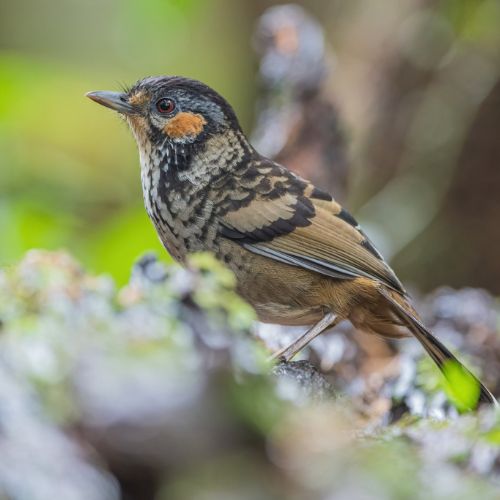The Chestnut-eared Laughingthrush, a Vulnerable species, is found in Vietnam’s Central Highlands. It thrives in montane forests and faces threats from habitat degradation.
Identification of Chestnut-eared Laughingthrush
The Chestnut-eared Laughingthrush is a shy bird, primarily gray with striking chestnut ear-coverts and bold barring across its upperparts. Its black-streaked gray forehead and white-tipped tail with a broad black sub-terminal band make it a distinct species within its range.

Distinctive Features:
This species stands out due to its chestnut ear-coverts, bold irregular barring on its upperparts, and the striking contrast of a white-tipped tail. Its song, a sweet, rambling series of notes lasting about 4-6 seconds, adds to its distinctiveness. With no similar species within its range, it is unmistakable.
Habitat Preferences:
The Chestnut-eared Laughingthrush is restricted to upper montane evergreen forests in the Central Highlands of Vietnam. It thrives in the dense undergrowth of forests dominated by species such as Fagaceae, Lauraceae, and Magnoliaceae. Typically found between 1,200-1,700 meters, this bird prefers areas with a canopy height of 10-20 meters, offering it both cover and foraging opportunities.

Behavioral Traits:
The Chestnut-eared Laughingthrush is often found foraging in the dense undergrowth of montane forests. Shy and elusive, it typically remains hidden from view, making it difficult to spot. Its sweet, rambling song can often give away its presence, even when the bird remains concealed. It is usually seen alone or in small groups.
More detail on this datazone of Birdlife.
Challenges and Conservation Status:
This species is currently listed as Vulnerable, primarily due to its very small range. Although its habitat is relatively intact, ongoing threats from logging, hydroelectric dam construction, and shifting cultivation could pose risks in the future. The population is estimated at 1,500 to 4,000 individuals. Conservation efforts are underway in Kon Ka Kinh Nature Reserve, which covers the type locality of this species and offers some level of protection.
How to Look for It:
To observe the Chestnut-eared Laughingthrush, it is essential to explore montane evergreen forests in the Central Highlands of Vietnam, particularly in areas with dense shrub layers. Early mornings offer the best chances to spot this shy species, especially by listening for its distinctive call. Patience and persistence are key, as the bird is elusive and tends to remain in dense cover.
Best Seasons to Spot:
The Chestnut-eared Laughingthrush can be observed year-round within its limited range. However, the dry season (December to April) provides the most favorable conditions for birdwatching. During this time, the bird is more active, and weather conditions are better for exploring its habitat.
Top 2 Locations to Spot the Chestnut-eared Laughingthrush:
1. Mount Ngoc Linh
- Specific Areas/Trails: The species was first discovered here, and the montane evergreen forests at elevations of 1,200-1,700 meters offer the best chance of sightings.
- Habitat Details: The forest is characterized by a dense undergrowth layer and a canopy of about 10-15 meters, making it ideal for the bird’s foraging.
- Best Times for Observation: Early morning is ideal, though the species is elusive at all times of day.
- Challenges: The rugged terrain and the bird’s secretive nature make it difficult to spot. Its habitat is fragmented, adding to the challenge.
2. Mang Canh Plateau, Kon Prong State Forest
- Specific Areas/Trails: This area has recorded several sightings of the Chestnut-eared Laughingthrush, with the bird being found in dense, mid-elevation forest.
- Habitat Details: The area consists of montane evergreen forests with a dense shrub layer, providing the perfect cover for this shy species.
- Best Times for Observation: Like Mount Kon Ka Kinh, early mornings offer the best opportunity to catch a glimpse of this elusive bird.
- Challenges: The species’ rarity and shy behavior make it a difficult bird to observe, even in known locations.
The Chestnut-eared Laughingthrush remains one of Vietnam’s rarest and most sought-after birds, making it a rewarding find for any determined birdwatcher.
Tour include the chance to spot the Golden-winged Laughingthrush
See below or click to go straight
Crocodile Trail – The Best Birding Trail in Cat Tien National Park
If you’re a birder or nature photographer planning a trip to Vietnam, few places offer [...]
Cong Troi Trail – Top 1 Dalat Plateau Birding Trail Experience
If you’re a birder or nature photographer planning a trip to Vietnam’s Central Highlands, the [...]
How to Identify the Greater Sand Plover, Tibetan Sand Plover and Siberian Sand Plover
ContentsIdentification of Chestnut-eared LaughingthrushHabitat Preferences:Challenges and Conservation Status:How to Look for It:Best Seasons to Spot:Top [...]
Highlights of Cat Tien National Park Reptiles and Amphibian Endemics
Spanning over 71,350 hectares of tropical forests, grasslands, and wetlands, Cat Tien National Park is [...]
Highlights of Cat Tien National Park Mammals in a World Biosphere Reserve
In addition to reptiles and birds, Cat Tien National Park is also rich in mammals, [...]
Kontum Plateau Endemic and Highlight bird
Kontum Plateau Endemic And Highlight Bird species like Chestnut-eared Laughingthrush and top birding routes while [...]